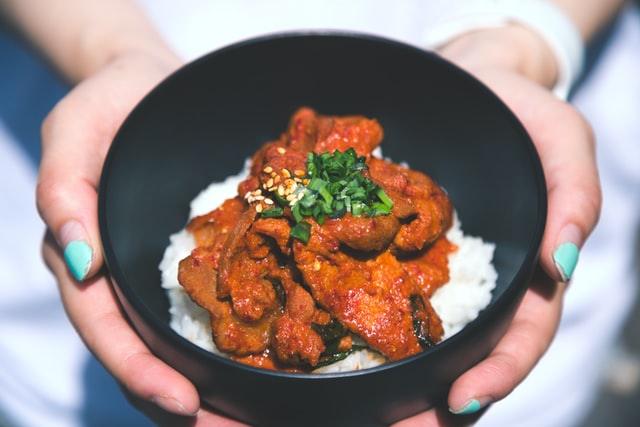Bulgogi (불고기) is the name of a Korean dish, literally translating to “fire meat.” This famous Korean dish has existed for thousands of years, and it is now gaining popularity in Western countries like the United States and Canada. Today, let’s take moment to better understand the history, preparation, and delicious nature of bulgogi!
Bulgogi Basics
At its most basic, bulgogi is marinated, grilled beef. As we will see, though, the marinade, meat selection, and method of cooking vary widely from place to place and from recipe to recipe.
Bulgogi History
Although the exact specifics are unknown, beef bulgogi is thought to have originated during the Goguryeo era, from roughly 50 BCE to 600 CE. Food historians believe it was called maekjeok (맥적, 貊炙) at the time. Maekjeok is primarily believed to have been a beef dish, often grilled and served on skewers.
Fast forward to the Joseon Dynasty (1392–1897), and it was called neobiani (너비아니), translating to “thinly spread” meat. During this time period, bulgogi was primarily reserved for the elite and members of the nobility class.
A 150-year old Korean history book, Dongguksesi (동국세시), details some of the histories of bulgogi. In this text it is referenced under the name yeomjeok (염적), translating to “fire meat.” In this method of preparation, the meat was skewered and grilled in small chunks. Modern bulgogi is not typically prepared in this method, but when skewered, it may take the name bulgogi sanjeok (불고기 산적).

Bulgogi Etymology
The history of the word bulgogi itself is rather interesting. It is derived from “bul” meaning “fire,” and “gogi,” meaning “meat.” The dialect from which the word is derived is the Pyongan dialect, hailing from the Pyongan Province, North Korea.
The dish is believed to have entered South Korea as a result of refugees fleeing Pyongan Providence after the liberation of the Korean Peninsula from the Japanese in 1945. After its introduction into South Korea, bulgogi became popular in Seoul and many other cities.
Bulgogi Preparation
Like many foods from many cultures, there is no single exact “right” way to prepare Korean beef. Although not the exact same, one could think of bulgogi as similar to steak in regards to the variety of means to prepare it.
For example, “steak” in the American lexicon typically utilizes beef, but many steakhouses across the country serve pork and fish steaks as well. Also, steak does not necessarily even come from the same cut of meat every time. Different types of beef steaks, such as tenderloin, New York strip, porterhouse, and ribeye all come from different cuts of beef. Furthermore, steak can be marinated, seasoned, and finished in a multitude of ways.
Meat
Bulgogi is typically prepared from beef, although pork or chicken are more common in some parts of Korea. A variety of different cuts are used, depending on the region and price. When beef is used, sirloin and ribeye are two very common choices. Similar to beef, pork bulgogi will often utilize pork belly due to its tenderness.
Marinade
Traditionally, almost all forms of bulgogi are marinated. The exact marinade ingredients, method, and time frame vary across different parts of Korea. There are several different parts to a bulgogi marinade. The first is the liquid component. Typically, this utilizes soy sauce and sesame oil.
Next, the marinade will have a variety of different spices. Chopped garlic, black pepper, red pepper, and brown sugar are among the most common ingredients. Ginger and whole garlic are also relatively common. Last, vegetables and mushrooms are incorporated. Scallions, onions, and a variety of different types of mushrooms are commonly seen.
Generally specific to pork variations of bulgogi, a spicy paste such as gochujang is sometimes added for an extra kick. Gochujang is typically made from rice, fermented soybeans, chili powder, barley, and salt. The paste is added along with the rest of the marinade ingredients.
All of these ingredients form the base of the marinade that is left to sit with the beef, pork, or chicken. Typically, bulgogi is left to marinate for around an hour. Depending on the region of Korea and the specific recipe used, this time may be longer, sometimes including an overnight marinate.
Preparation
Traditionally, the strips of marinated bulgogi meat were grilled. This is still relatively common, and American consumers may recognize this method from Korean Barbeque restaurants around the United States. In recent years, pan-frying in a skillet has become increasingly common. When pan fried, the addition of more vegetables and whole cloves of garlic is very common. Green peppers and onions are frequently included additions.
Presentation
Once the bulgogi has been marinated and cooked, it’s time to serve! Bulgogi is typically considered a “main dish,” so it is usually served with a variety of side dishes. Depending, again, on the location and recipe, a variety of different side dishes may be served.
- Lettuce: lettuce (or other leafy vegetable) is often served as a means to “wrap" the bulgogi. Other side dishes often are included in the wrap.
- Rice: a variety of different types of rice may be used, and the rice will usually go inside the leaf wrap.
- Egg soup: Americans may be more familiar with egg drop soup of the Chinese persuasion, and the Korean variety shares some similarities. Notably, Chinese egg drop is usually based on a chicken or meat broth base, but Korean egg drop typically utilizes an anchovy or seaweed broth base.
- Ssamjang: this classic sauce is often included with bulgogi. It is somewhat similar to gochujang, typically using that sauce as a base. Additional ingredients usually include garlic, sesame, onion, and garlic.
- Kimchi: this classic Korean side dish composed of fermented cabbage is often served with bulgogi.

Bulgogi Recipe
Now that we know about bulgogi, let’s learn how to actually prepare one of our favorite Korean recipes. The following is a basic recipe and many different substitutions can be made. Prep time for this Korean beef bulgogi is about 30 minutes, excluding marination. The total time to cook this delicious bulgogi is only about 20 minutes, making it a perfect weeknight dish. The nutritional facts (kcal, cholesterol, saturated fat, carbohydrates, etc) will greatly depend on the specific meat and side dishes incorporated.
Ingredients
- 1lb boneless rib-eye steak (flank steak, skirt steak , or short rib will work as well, even top sirloin)
- 1/3 cup reduced-sodium Soy Sauce
- 1.5 tablespoons toasted sesame oil
- 1 tablespoon gochujang (red pepper paste)
- 2 tablespoons vegetable oil
- 1 small Asian pear
- 3 cloves garlic, minced
- 1 tablespoon freshly grated ginger
- 2 green onions, sliced thinly
- 1 teaspoon The Happy Ms. Jungeun Toasted Sesame Seeds
- 1.5 tablespoons brown sugar
Directions
- It may sound a little odd, but place the rib-eye in the freezer (you read that right) for about 20 minutes beforehand. This will make slicing the meat thinly much easier.
- Slice steak across the grain into thin slices about ¼ inch thick.
- In a medium-sized bowl, combine soy sauce, sesame oil, ginger, garlic, pear, gochujang, and brown sugar.
- Combine meat and mixture into a 1-gallon-sized plastic bag. Allow marinating from one hour to overnight. If you can be prepared ahead of time, an overnight marinate will produce a more intense flavor.
- Heat vegetable oil in a cast-iron skillet over medium-high heat on the stovetop. If you don’t have a cast iron, any large pan will do. Add marinated meat to the cast iron once hot, in a single layer. Cook each side 2-3 minutes, flipping in-between. Meat should be cooked through and appeared almost charred. There should be an obvious sear on both sides.
- Let the sliced meat “rest” for a few minutes in order to reabsorb juices. This is a great time to prepare lettuce wraps, kimchi, veggies, and other side dishes.
- After resting, serve immediately with side dishes. Garnish with sesame seeds and/or red pepper flakes if desired.
Keywords: South Korea, Korean food, korean recipe, bulgogi, Korean bulgogi, soy sauce, sesame oil, kimchi


